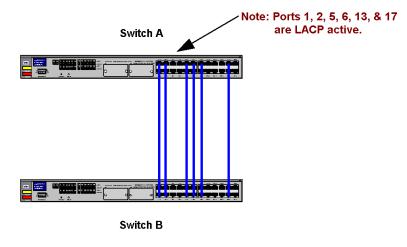HP 2524, 2512 User Manual 2

Dynamic LACP Trunking
The example configurations below provide dynamic trunking between two HP Procurve Series 2500 Switches (Switch A and Switch B) using LACP (802.3ad) as the trunking protocol.
Another benefit, besides dynamic trunk formation, of an LACP trunk is port redundancy. If one of the operational ports fails then one of the redundant "standby" ports becomes operational without any user intervention.
To create a dynamic LACP trunk, configure ports at one end of the link to be LACP active - and ensure that LACP is enabled at the other end.
Switch A is configured to provide six LACP active ports. Since the Series 2500 Switches support one trunk group of up to four ports, the other two ports will be redundant "standby" ports.
Switch B is in its default configuration. As stated above for a dynamic LACP trunk, once one end of the link is configured for LACP active, the only other requirement is that the port at the other end of the link must have LACP enabled. Since the Series 2500 Switches have LACP enabled by default, there is no need to modify Switch B from its default configuration.
This configuration example applies to the following products:
J4812A HP Procurve Switch 2512
J4813A HP Procurve Switch 2524
©Copyright Hewlett-Packard Company, 2000. |
Page 1 |
All rights reserved. |
|
WARNING:
The example configurations below were created from a factory default configuration on the Series 2500 Switches. The first command in the sequence of CLI commands given below will first reset a Series 2500 Switch back to its factory default settings. We recommend saving your current configuration if necessary. Otherwise, skip the first command.
NOTES:
1.By default, LACP is enabled (all ports are set to LACP passive) on the Series 2500 Switches. For a dynamic LACP trunk to form, at least one end of the link must be LACP active.
2.The Series 2500 Switches support one trunk group of up to four ports, and the ports need not be consecutive or contiguous on the switch.
3.Dynamic LACP trunks are always created in the DEFAULT_VLAN of Series 2500 Switches. That is because the LACP protocol does not send VLAN information, so the switches have no way to know what VLAN or VLANs to put the trunk into.
4.There is no limit, besides the number of physical ports available on the switch, on the number of "standby" ports in an LACP trunk group.
5.If STP and/or IGMP is enabled in the switch, a dynamic LACP trunk operates only with the default settings for these features and does not appear in the port listings for these features.
6.Port security does not operate on a trunk group.
7.The configuration examples below were created on software version F.01.07.
REQUIREMENTS/RESTRICTIONS:
1.All port trunk links must be point-to-point (i.e., coterminus) connections between the Switch 2512 or 2524 and another switch, router, server, or workstation configured for LACP trunking. No intervening, non-trunking devices are allowed.
2.LACP will only operate on full-duplex links.
3.All ports in a trunk group must have the same media type, mode (speed and duplex) and flow control settings.
4.Always configure port trunking before you connect links to another switch. Otherwise, a network topology loop (i.e., broadcast storm) could occur.
©Copyright Hewlett-Packard Company, 2000. |
Page 2 |
All rights reserved. |
|
